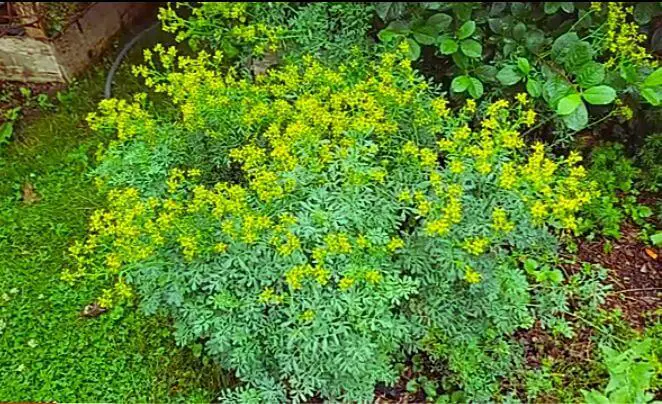
The Rue plant whose scientific name is Ruta Graveolens is a perennial shrub-like herb. The Rue plant belongs to a family of plants called Rutaceae. This amazing herb originated from the Balkan Peninsula though it has recently spread to Europe, Asia, and North Africa. This plant is used for culinary purposes because of its strong aromatic leaves. Rue plant leaves can be used when fresh or dry in any amount depending on the aim of the user
Physical Appearance and Description of Rue Plant
It’s a shrubby plant with green-hairy leaves and forms small yellow flowers during blooming. Sometimes the rue leaves may look bluish especially when they are growing under high temperatures. The flowers are small with dull yellow petals in clusters. The rue plant flowers have brown seed capsules when pollinated.
Types of Rue Plant
There are several varieties of Rue plants including:-
1. Variegata
It has dark green leaves with some white spots on them.
2. Blue Beauty
This is one of the most beautiful varieties of rue plant, it has blue-green leaves.
3. Jackmans Blue
This variety is popular because of its nice aroma, it also has blue foliage.
How To Grow Rue Plant
Rue needs full sun to partial shade. Choose a spot that gets at least 6 hours of direct sunlight per day. Rue can be grown outdoors or in a container. Make sure it’s positioned in well-draining soil. It grows best in sandy, well-draining soil with a pH of 6.1-7.8. Add compost or organic matter to enrich the soil.
If grown from seed, sow them just below the soil surface. Space seeds 12-18 inches apart if transplanting seedlings. Rue can also be propagated from cuttings. Water rues regularly so the soil is moist but not soaked. Established plants are drought tolerant but overhead watering can cause powdery mildew on the leave
Rue thrives in hot, dry conditions. It needs temperatures between 60-80°F during the day and shouldn’t be exposed to frost. Low humidity is best. Apply a general-purpose fertilizer in early spring. Prune lightly after flowering to promote bushy growth. Dividing mature plants every 2-3 years will keep them vigorous.
Watch for aphids, whiteflies, and leaf miners. Improve air circulation and spray neem oil or insecticidal soap to prevent infestations. Powdery mildew can also be an issue. Snip sprigs as needed once the plant is established. Use leaves fresh or dried. The seeds and roots are also used medicinally.
How To Care For Rue Plant
Light
Rue plants need at least 6 hours of full sun per day. Provide the sunniest location possible. if you are planting Rue plant indoors make sure to place it in the south-facing window to access enough sunlight.
Soil
Plant rue in well-draining soil. They like sandy or loamy soil. Too much water or soggy soil may cause root rot which may cause the rue plant to dry. Maintain a soil pH between 6.1lan-7.8. Rue prefers neutral to slightly alkaline conditions. Acidic soil stunts the growth of rare plants.
Water:
Don’t water rue plants. Let the soil dry out some between waterings. Drought tolerant once established. Too much moisture encourages fungal diseases.
Fertilizer
Fertilize lightly in the early spring with a balanced liquid fertilizer or compost tea. Compost manure is the best for rue if it’s available. Before planting mix the compost manure with the garden soil thoroughly.
Pruning
Prune lightly after flowering to maintain shape. Dividing overgrown plants every 2-3 years will rejuvenate them. The pruned leaves and branches can be used or placed in the garden to decay.
Pest control
Watch for aphids and spider mites. Use horticultural soaps or neem oil. Powdery mildew can also be a problem. Provide good airflow.
Temperatures
Rue can tolerate high heat but not frost or freezing. Grow as an annual if your climate gets colder than 20°F. Caring properly for soil, moisture, and pest prevention will keep rue growing first. Trim back and divide when overgrown.
What Are Uses For Rue Plant
1. Culinary Uses
Rue has a bitter, strong flavor and is used sparingly as a seasoning herb in Mediterranean, Italian, and Balkan cuisine, especially with meats, olives, and vinegar.
2. Medicinal Uses
Rue has historically been used to treat several conditions including rheumatism, arthritis, eye issues, and menstrual cramps, and is thought to increase circulation.
It has also been utilized as an antidote for poison, insect repellant, and to induce menstruation. Howevr, rue should be used cautiously for internal medicinal uses.
3. Ornamental Uses
Rue makes an attractive garden plant, with blue-green leaves and small yellow flowers. It works nicely in rock gardens, herb gardens, and flower beds. The plant has a unique appearance and provides visual interest and contrast when paired with brightly colored blossoms.
5. Insect Repellant
Rue contains compounds like methyl nonyl ketone and other essential oils that naturally deter insects. The leaves can be used fresh or dried in insect sprays and powders.
However, it’s important to apply rue cautiously on the skin as it can cause photosensitivity in some people. Ingestion of the plant can cause severe stomach issues in certain cases.
Also Read:-
Watercress Plant, Growing, Harvesting.
CREEPING CHARLIE LOOK ALIKES-Seven plants that look like Creeping Charlie
